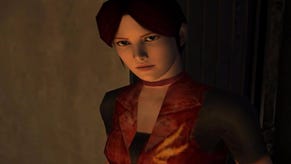Resident Evil: Code Veronica HD
Polishing the CV.
Code Veronica is the lost Resident Evil, a game caught in the awkward evolutionary transition between the series' shuffling, B-movie beginnings on PlayStation and its transformation into the most important action game of the past decade with the fourth core entry in the series.
Released for the Dreamcast in 2000 (and later for the PS2 and GameCube, upon which this HD port for Xbox Live and PlayStation Network is based), it was the first game in the series to abandon the pre-rendered backgrounds that had defined Racoon City in favour of dimly lit polygons. But this was the only evolutionary step for a game that held fast to the semi-fixed camera angles, agonizing control scheme, camp dialogue and protracted loading transitions that were as much a part of the Resident Evil aesthetic in its formative days as the groaning zombies and rabid Doberman. It was, even upon release, a game stuck somewhere between the past and the future of video games.
As such, this reissue (and make no mistake, this is a reissue rather than a remake, the HD tagline justifiable only in regard to the crisp new menu screens) is a wholly different creature to last week's Resident Evil 4 HD. Where the fourth game in Shinji Mikami's series is a prominent feature within the gaming canon, Code Veronica is a less familiar quantity, boasting none of that cultural cachet or legacy.
But familiarity isn't the only distinction between the reissues of Code Veronica and Resident Evil 4. The latter is an unapologetic action horror game, a game that allows players to counter the frights with a fearsome power of their own. Code Veronica, meanwhile, is survival horror in the classic sense, a game that achieves its atmosphere of dread through unflinching disempowerment. It allows us to experience that nightmarish feeling of being preyed upon with little more than a knife and a lighter to hold back the onslaught.
The earliest survival horror titles owed their success to technical limitations as much as poised design. Poor cameras, bewildering controls and a complicated interface all contributed to a sense of powerlessness, making players feel weak and confused. The best examples of the genre from this era are those that used the limitations of their host console to great effect, such as Silent Hill's draw-distance-obscuring fog.
But in the context of its turn-of-the-millennium release, Code Veronica was an electric proposition. Here was a game no longer constrained by technology like its forebears, finally able to elicit fear through in-context design. However, returning to the game today, it's clear that Capcom was yet to expand its vision to fill the spaces widened by the arrival of the Dreamcast.
The control scheme makes even the most spatially aware player feel like they've lost all motor skills. You swivel your character on the spot, the relative up, down, left and right directions shifting depending on the viewpoint the fixed camera has on your position, making it likely you'll run into the open arms of a zombie for a death cuddle when you meant to flee. Neither can you walk and shoot, instead forced to remain rooted to the spot to line up an attack.







